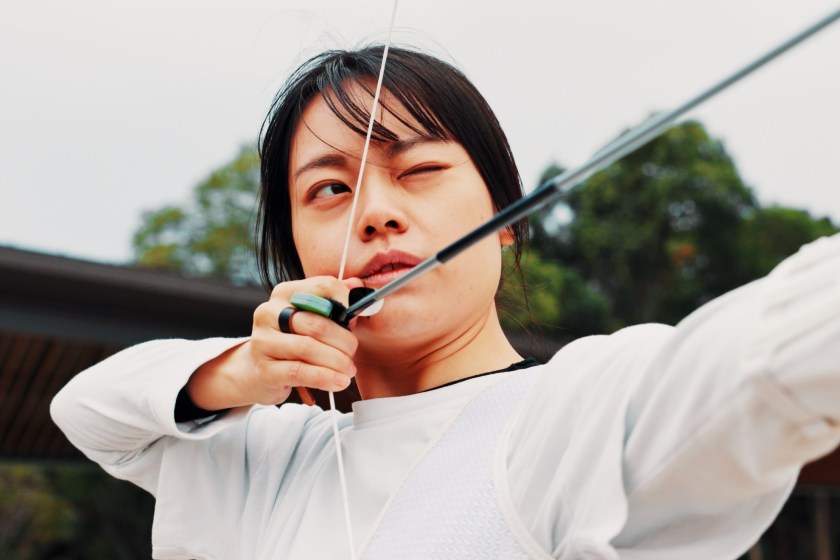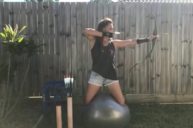Turns out there is a lot more to archery than just aim and shoot. Not only is it more complicated than I anticipated but it is also a lot cooler than I imagined. Just this past weekend I was fortunate enough to attend my very first archery lesson. While it was called Archery 101 it was not as simple as I imagined. However by the end of the two hour course I felt like a pro! Here are 10 interesting things I learned about archery during my first lesson that I wasn't expecting.
1. Archery Is A Full Body Sport

Photo of me at archery class taken from my I phone
When thinking of archery I just imagined using my hands, arms, and shoulders. However it requires your entire body. You need to take a wide stance, with one leg in front of the other. You also need to have a strong and firm core and back. Then, yes your upper body better be strong because those bows are heavy and you will be holding and pulling them back. However I was surprised to learn just how involved each part of my body was when shooting.
2. Slight Adjustments Are The Key To Success

Shutterstock Image
Turns out if you want to get better at archery, you just need to make slight adjustments. The key is to only change one thing at a time. So don't change your aim, the way you are holding the bow, and your anchor point all at once. Instead shoot until you get consistently in one area of the target. Then adjust one factor at a time and see how it affects your shot. For example, I was continuously shooting low on the target but I wanted to hit the bullseye. After shooting 2-3 shots low I changed the aim of my bow. I titled just slightly up but changed nothing else, then I got a bullseye!
3. The Breath Is Super Important

Shutterstock Image
One of the most interesting things I learned about archery during my lesson was that the breath is super important. The key is you take your aim and pull the bow back. Hold it in position while you take a deep inhale. Ensure your shot is lined up how you want it and then exhale as your release your shot. Sounds silly but trust me, this works! Any time I didn't breathe, I missed. Every time I set up the shot and took the breath, I hit the mark.
4. Fletching Colors Matter
The arrows that we used did not have feathers. Instead, the fletching was made of plastic. It consisted of three vanes, two of which had a color and one that was white. Our instructor made sure to tell us that you want the white vane facing away from your bow. The reason for this is if the white part is facing in, the bow can catch and you can lose your accuracy.
5. Never Dry Fire

Image of me at the archery class taken with my I-phone
This was another one of the interesting things I learned about archery during my first lesson — dry firing is dangerous. Dry firing refers to when you shoot a bow and arrow without the arrow in it. I personally never thought of this as dangerous. After all, there is no arrow in there so what is the harm? Louisiana Sportsman sums it up perfectly. They explain that when you are shooting an arrow there is a proper weight and energy transfer into the shot. However if you dry fire "the energy that would have been transferred to the arrow has to go somewhere." Unfortunately it usually goes back into the bow, or back into you. "The excess energy is dissipated as vibration and noise, and it often does severe damage to the bow." Occasionally it can harm the archer as well.
6. Finger Placement Matters

Shutterstock Image
This may seem like an obvious one, but as a novice I had no idea. Our instructor had a small notch on our bow string signaling where our nocking point for our arrow should be. Then, she shared that we should place three fingers beneath that point and our arrow — ensuring that just the finger pads rested on it. She also suggested if we find that our shots were going too low, to scoot our fingers down further to help give the arrow height. I tried it and it worked!
7. There Are Different Bows For Different Levels

Shutterstock Image
Archers have different experience levels and preferences. Therefore, there are different bows. Just at our beginner class there were three types of bows. For those who were very new she offered the recurve bow, which was more lightweight and easier to pull back. However it required more effort to keep the string pulled back and I found that it didn't shoot as far. Then she had two types of compound bows — the same bow but with different weights. I liked the compound bow with the lighter weight as it was easier to hold but still did most of the work for me.
8. Turning The Bow Sideways To Load Helps

Shutterstock Image
Ironically, the thing I had the hardest time with in my class was loading the bow. I know...who would have thought putting the arrow on would be harder than shooting the darn thing? Trust me, it is not as easy as it looks. Between the notch point, the arrow rest, and making sure your vane is facing the right way, there was a lot to pay attention to. Luckily, my instructor shared this tip with me. If you tip your bow horizontal, so it is laying on its side, it is easier to load. Then once you are properly loaded just tilt your bow back to firing position and line up your shot. Just ensure you don't bump your arrow when turning the bow. This tip saved me so much frustration.
9. You Need A Consistent Anchor Point

Shutterstock Image
Your anchor point refers to the place on your body and the bow that you consistency set up. For me it was three fingers near the very bottom of the bow string. Additionally, I would pull the bow back until the knuckle of my thumb was resting against the back of my jaw — almost directly under my ear. It is a bit scary at first bringing the bow that close to your face but it helps. Having a consistent anchor point allows you to learn how you are shooting and what you need to adjust.
10. Archery Is A Very Inclusive Sport

Shutterstock Image
Finally another one of the interesting things I learned about archery during my first lesson is that it is a very inclusive sport. This was one of my favorite things that I learned because I love an activity where everyone can get involved. Not only can various ages participate in this sport but it is friendly for individuals in wheelchairs too. It is truly a very fun and rewarding activity and I highly recommend trying it at least once in your lifetime!
Enjoy this video of me hitting one of my first bullseyes after popping the ballon in the center of the target.




